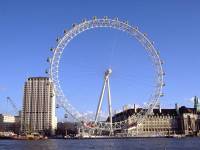

While the City of London immediately to the east is the original heart of London, it is Westminster that is nowadays regarded as the centre of both the capital and the nation. Westminster is Britain's centre of government. Westminster is where the Queen and the Prime Minister have their official residences. Westminster has the shops, the theatres, the entertainment and the nightlife. Westminster is what the tourists come to see. Westminster is, in effect, Central London.
The City of Westminster, though, is more than just London's hub. It covers an area of seven square miles, or over 20 sq km, and has a population approaching 150,000. Most of it, in fact, is residential. It was created in the 1963 reorganisation from the old Metropolitain boroughs of Westminster, Marylebone and Paddington; Westminster itself was formed from the amalgamation of the ancient parishes of St George, St James and St Martins.
There is evidence that a Saxon town ("Lundenwic") existed immediately west of the City, in the Charing Cross/Strand area, but Westminster as such owes its true foundation to Edward the Confessor, who in the 11th century established an abbey on an island in the marshes of the Tyburn estuary. The modern Westminster Abbey occupies this same site. Edward also built a hall here, and was buried here, and his successor was crowned here; Westminster was thus established as the centre of Royal administration. It continued thus. Both the Palace and the Abbey were extended by successive monarchs; offices of the government were established in the vicinity; courtiers, administrators and the nobility took up residence. By Tudour times there were eight major Royal palaces in London. Two of these (Bridewell Palace and Baynard Castle) were situated in the City and no trace of either remains; three others were here in Westminster within a mile of each other. They were the Palace of Westminster, St James's Palace and the Palace of Whitehall. Between the three a private Royal pleasure ground, St James's Park, was laid out. The park still exists, of course, and is still surrounded by palaces; Buckingham House, a country mansion at its western end, was remodelled by Nash and is now Buckingham Palace. St James's Palace still exists, and is abutted by Clarence House and Lancaster House; all three contain royal apartments, offices and ceremonial rooms. The original Palace of Westminster was destroyed by fire in 1834 and was replaced shortly after by the present building, better known as the Houses of Parliament. Whitehall Palace was largely destroyed in 1698 but its site is now occupied by various Ministry buildings, notably the Treasury, the Foreign Office and the Ministry of Defence. A tiny lane fronted by old Treasury offices - Downing Street - is the official residence of the Prime Minister.
The rest of what we now know as central London was largely developed during the eighteenth century, as a number of aristocratic landowners began to construct grids of streets and squares on what until then were country estates west of the City. This was the golden age of Geogian architechture and much of the construction was designed or inspired by Nash, Adam and their contemporaries. The Portman, Bedford, Grosvenor, Fitzroy, Belgrave, Cavendish, Carlton, and Portland estates were just some of the the building developments that appeared then; many of them are little changed. The changes that have taken place are from the residential to the commercial. The new opulence of the area attracted retailers, upmarket, flamboyant and specialist; shops and departments stores spread along Oxford Street and its surrounds. In the wake of the shops came the places of entertainment and leisure; theatres and gentlemens' clubs, art galleries, restaurants and cinemas. There was early specialisation and there still is. The clubs are centred on Pall Mall, the theatres around Shaftesbury Avenue, high fashion is in Bond St, books in Charing Cross Road, foreign restaurants and music shops in Soho, cinemas around Leicester Square, consumer electronics in Tottenham Court Road, youth and cult trends in Covent Garden and Carnaby St. And, while London's financial services have concentrated in the City, the various "media" industries have settled here in Westminster; publishing, advertising, theatre, music, the film industry and TV production companies invariably have their offices within fifteen minutes' walk of Soho Square. There are population clusters, too; London's Chinatown is concentrated within a few blocks on the southeastern corner of Soho, for instance, while Belgravia is still something of an aristocratic quarter. Many of Britain's foreign embassies are found within Mayfair and Marylebone.
Apart from the numerous squares, Westminster has few green spaces of its own outside the Royal parks complex of St James's Park and Green Park. Hyde Park, London's best known open space, is shared with Kensington; Regents Park, in the northeast of the city, is shared with Camden and is the home of London Zoo. Just about all parts of Westminster north and west of Paddington railway station are residential and lay outside the scope of "central" London, largely untouched by the visitor. One major exception, however, is Lord's cricket ground in St John's Wood, the home of this most English of field sports.
 |
Westminster Bridge |
 |
St James's Park and Buckingham Palace |
 |
The Embankment |
Back to London Cityscapes index
This page last updated 13th January 2005
![]()